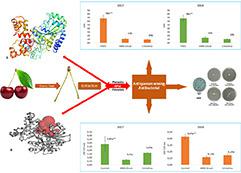当前位置:
X-MOL 学术
›
Lett. Appl. Microbiol.
›
论文详情
Our official English website, www.x-mol.net, welcomes your
feedback! (Note: you will need to create a separate account there.)
Phytochemical profile, antimicrobial, and anti-quorum sensing properties of fruit stalks of Prunus avium L.
Letters in Applied Microbiology ( IF 2.0 ) Pub Date : 2021-06-26 , DOI: 10.1111/lam.13528 E Önem 1 , H C Sarısu 2 , A G Özaydın 3 , M T Muhammed 1 , A Ak 4
Letters in Applied Microbiology ( IF 2.0 ) Pub Date : 2021-06-26 , DOI: 10.1111/lam.13528 E Önem 1 , H C Sarısu 2 , A G Özaydın 3 , M T Muhammed 1 , A Ak 4
Affiliation

|
The aim of this study is to investigate the phytochemical contents and antibacterial properties of 2-year Prunus avium L. standard cultivars [Cristalina (Cr), 0900 Ziraat (Zr)] and to elucidate the mechanism of action of the extracts on the quorum sensing (QS) system by using homology modelling and molecular docking. Phenolic contents of methanol extract of Cr and Zr stalks were detected by HPLC. As a result, catechin hydrate (6364·67–8127·93 µg g−1) and chlorogenic acid (998·81–1273·4 µg g−1) were found to be the highest in stalk extracts in the two varieties in 2017. All extracts had inhibitory effect on Gram-positive bacteria. Stalk extract of Zr showed higher inhibition rate (86%) on swarming motility. Stalk samples of Zr collected in 2017 and 2018 also reduced biofilm formation by 75 and 73%, respectively. The computational analysis revealed that one of the major component of the extracts, chlorogenic acid, was able to bind to the QS system receptors, LasR, RhlR, and PqsR. Therefore, the mechanism of decreasing the production of virulence factors by the extracts might be through inhibiting these receptors and thus interfering with the QS system.
中文翻译:

Prunus avium L 果实茎的植物化学特征、抗菌和抗群体感应特性。
本研究的目的是调查 2 年生Prunus avium L. 标准品种 [Cristalina (Cr), 0900 Ziraat (Zr)]的植物化学成分和抗菌特性,并阐明提取物对群体感应的作用机制(QS) 系统通过使用同源建模和分子对接。高效液相色谱法检测了铬和锆的甲醇提取物的酚类含量。结果,儿茶素水合物 (6364·67–8127·93 µ g g -1 ) 和绿原酸 (998·81–1273·4 µ g g -1)在2017年两个品种中茎提取物含量最高。所有提取物对革兰氏阳性菌均有抑制作用。Zr的茎提取物对蜂群运动的抑制率较高(86%)。2017 年和 2018 年收集的 Zr 茎样本也分别减少了 75% 和 73% 的生物膜形成。计算分析表明,提取物的主要成分之一绿原酸能够与 QS 系统受体 LasR、RhlR 和 PqsR 结合。因此,提取物减少毒力因子产生的机制可能是通过抑制这些受体从而干扰QS系统。
更新日期:2021-06-26
中文翻译:

Prunus avium L 果实茎的植物化学特征、抗菌和抗群体感应特性。
本研究的目的是调查 2 年生Prunus avium L. 标准品种 [Cristalina (Cr), 0900 Ziraat (Zr)]的植物化学成分和抗菌特性,并阐明提取物对群体感应的作用机制(QS) 系统通过使用同源建模和分子对接。高效液相色谱法检测了铬和锆的甲醇提取物的酚类含量。结果,儿茶素水合物 (6364·67–8127·93 µ g g -1 ) 和绿原酸 (998·81–1273·4 µ g g -1)在2017年两个品种中茎提取物含量最高。所有提取物对革兰氏阳性菌均有抑制作用。Zr的茎提取物对蜂群运动的抑制率较高(86%)。2017 年和 2018 年收集的 Zr 茎样本也分别减少了 75% 和 73% 的生物膜形成。计算分析表明,提取物的主要成分之一绿原酸能够与 QS 系统受体 LasR、RhlR 和 PqsR 结合。因此,提取物减少毒力因子产生的机制可能是通过抑制这些受体从而干扰QS系统。











































 京公网安备 11010802027423号
京公网安备 11010802027423号